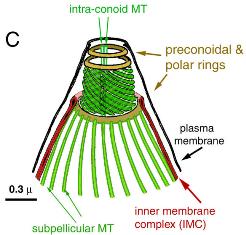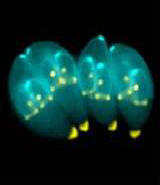Adaptation
The main adaptation of T. gondii is the apical complex, an anterior structure
found in all apicomplexans used for burrowing into host cells and
for reproduction. The central part of the apical complex is the
conoid which is made of hundreds of fibers arranged in a spiral.
This structure acts like a drill bit during host cell invasion. The
apical complex can retract and extend, and also secrete compounds
that aid in attachment and penetration. For more information about
the apical complex, I suggest reading this
paper by Ke Hu et. al (10).
of T. gondii is the apical complex, an anterior structure
found in all apicomplexans used for burrowing into host cells and
for reproduction. The central part of the apical complex is the
conoid which is made of hundreds of fibers arranged in a spiral.
This structure acts like a drill bit during host cell invasion. The
apical complex can retract and extend, and also secrete compounds
that aid in attachment and penetration. For more information about
the apical complex, I suggest reading this
paper by Ke Hu et. al (10).
T. gondii lacks flagella and cilia, but can move via cell crawling. This suits the organism since other forms of motility would be useless for muscling into and between host cells. This organism also has small air sacs beneath its plasma membrane called alveoli. These are flattened vesicles that add support to the membrane and form a pellicle like shell (9).
Toxoplasma also has some amazing adaptations for hiding inside host cells without causing too much harm while waiting to be ingested by it's secondary host. After encysting, this organism releases a compound that boosts the number of T cells in the host's body. This makes every macrophage in the body an effective Toxoplasma killer. Only those Toxoplasma that hide inside cysts will be safe from the immune response. In this way, the parasite won't overtake the host's body, killing it (8). It is amazing how this protist can so elegantly manipulate the immune system for its own benefit!
T gondii's most amazing adaptation is its ability to change host behavior. When this organism encysts in a mouse it will actually cause the mouse to be less afraid of cat smells. In some cases, mice infected with Toxoplasma will actually seek out cat smells and stay in the area for long periods of time. Under normal, uninfected circumstances mice go into a panic when they smell cats. After smelling cats they learn to stay away from areas where they experienced the smell. After infection with Toxoplasma these learned behaviors change so that the mice are no longer afraid of cat smells. This means that T. gondii hijacks mouse brains so that it is easier for these mice to be eaten by cats, which are the secondary hosts that T. gondii needs (11)!
Top | Life Cycle | Home | Interesting Facts
